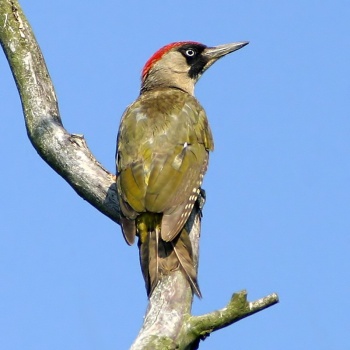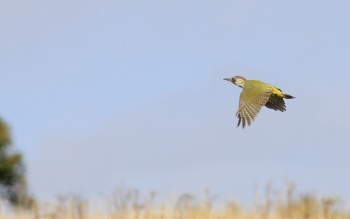- Picus viridis
Identification
30-36 cm
- Dark green upper parts
- Yellowish-green under parts
- Red crown and nape
- Black face mask and moustachial stripe
- Yellow rump
- Black and white outer primaries
- Grey bill and feet
Sexes similar except male has a crimson centre to the moustache
Juvenile: duller and has whitish barred underparts
Variation
The Iberian race P. v. sharpei which lacks the black mask and moustache.
Similar Species
Distribution
Generally common and widespread over much of range. Breeds in Britain north to central Scotland, and from Iberia and France east to about 50 degrees east in Russia, also in Iran, Turkmenistan and Pakistan. In the north found in coastal and southern parts of Norway and Sweden, Poland and the Baltic States. Occurs south to the north Mediterranean coast from southern Spain to Greece and Turkey and also found in the Caucasus.
Resident throughout range with only short-distance dispersal but may move further in the east as a result of more severe winter weather. Vagrants have been recorded in Ireland and Finland, Malta and the Balearics.
Taxonomy
Subspecies
There are 4[1]
- Nominate race is found over much of range (Britain south to France, Alps, northern Yugoslavia and Romania)
- karelini: which is duller and greyer than the nominate
- The Iberian race sharpei is more distinct; the face is much greyer with black confined to lores and little or no barring on the underparts, moustachial stripe of male has much more red.
- Iberian Peninsula and the Pyrénées
- innominatus is found in western Iran and bampurensis in Baluchistan.
bampurensis is generally considered invalid
Habitat
Deciduous or mixed woodland, generally in more lowland areas than Grey-headed Woodpecker. Common in parks and large gardens, and also open areas with scattered trees, especially in winter.
Behaviour
Usually solitary or in pairs, feeds mainly on the ground, often 'star-gazes'.
Flight
Markedly undulating flight, caused by prolonged closure of wings.
Breeding
They drill out holes in trees for the nest.
Diet
Insects are captured by a rapid outward flick of the long tongue, gummed to its tip by sticky saliva. Green Woodpecker likes very much to eat ants. So, birds from this species can be seen searching and eating ants on the ground (a behaviour not very common for European woodpeckers).
Vocalisation
Call: A loud plue, plue, plue, which sounds like a laugh, or "yaffle", from which it gets the country name
<flashmp3>Picus viridis (song).mp3</flashmp3>
Listen in an external program
References
- Clements, J. F., T. S. Schulenberg, M. J. Iliff, B.L. Sullivan, C. L. Wood, and D. Roberson. 2012. The eBird/Clements Checklist of Birds of the World. 6th ed., with updates to October 2012. Ithaca: Cornell Univ. Press. ISBN 978-0801445019. Spreadsheet available at http://www.birds.cornell.edu/clementschecklist/downloadable-clements-checklist
- Avibase
- Collins Field Guide 5th Edition ISBN 0 00 219900 9
- AvianWeb
Recommended Citation
- BirdForum Opus contributors. (2024) Eurasian Green Woodpecker. In: BirdForum, the forum for wild birds and birding. Retrieved 28 April 2024 from https://www.birdforum.net/opus/Eurasian_Green_Woodpecker
External Links







